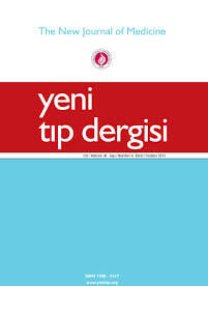Koroner anjiyografi için refereedilen hastalarda bozulmuş açlık glukoz toleransı ciddi koroner arter hastalığı riskini öngördürebilir mi ?
Could impaired fasting blood glucose levels predict the risk of coronary artery disease in patients which referred to coronary angiography?
___
- 1.
- Genuth S, Alberti KG, Bennett P, Buse J, Defronzo R, Kahn R, et al. Expert committee on the diagnosis and classification of diabetes mellitus: follow-up report on the diagnosis of diabetes mellitus. Diabetes Care 2003;26: 3160-7. 2.
- DECODE Study Group, European Diabetes Epidemiology Group. Is the current definition for diabetes relevant to mortality risk from all causes and cardiovascular and noncardiovascular diseases? Diabetes Care 2003;26: 688-96. 3.
- Wen CP, Cheng TY, Tsai SP, HSU HLİ Wang SL. Increased mortality risks of prediabetes (impaired fasting glucose) in Taiwan. Diabetes Care 2005;28: 2758-61. 4.
- Levitan EB, Song Y, Ford ES, Liu S. Is nondiabetic hyperglycemia a risk factor for cardiovascular disease? A meta-analysis of prospective studies. Arch Intern Med 2004;164: 2147-55. 5.
- Dong X, Zhou L, Zhai Y, Wang D, Shi H, Luo X, et al. Impaired fasting glucose and the prevalance and severity of angiographic coronary artery disease in high-risk Chinese patients. Metabolism Clin Experimental 2008;57: 4-29 6.
- Sasso FC, Carbonara O, Nasti R, Campana B, Marfella R, Torella M, et al. Glucose metabolism and coronary heart disease in patients with normal glucose tolerance, JAMA 2004;291: 1857-63 7.
- Drexel H, Aczel S, Marte T, Benzer W, Langer P, Moll W, et al. Is atherosclerosis in diabetes and impaired fasting glucose driven by elevated LDL Cholesterol or by decreased HDL Cholesterol? Diabetes Care 2005;28: 101-7. 8.
- Coutinho M, Gerstein HC, Wang Y, Yusuf S. The relationship between glucose and incident cardiovascular events: a metaregression analysis of published data from 20 studies of 95783 individuals followed for 12.4 years. Diabetes Care 1999;22: 233-40. 9.
- Nurkalem Z, Sargın M, Alper AT, Uyarel H, Sargın H, Samur H, et al. Nondiabetik akut koroner sendrom vakalarında postprandiyal hipergliseminin koroner lezyonlarla ilişkisinin araştırılması. Endokrinolojide Yönelişler 2003;12: 175-8. 10.
- Balcı B, Mahmut Ş, Karakelleoğlu Ş, Şenocak H, Ateşal S, Alp N. Plazma insülin düzeyi ile koroner arter hastalığının anjiyografik ağırlığı arasındaki ilişki. Türk Kardiyol Dern Arş 2000;28: 617-21 11.
- Wascher TC, Sourij H, Roth M, Dittrich P. Prevalence of pathological glucose metabolism in patients undergoing elective coronary angiography. Atherosclerosis 2004;176: 419-21.
- ISSN: 1300-2317
- Yayın Aralığı: 4
- Başlangıç: 2018
- Yayıncı: -
Gelişimsel farmakoloji: Çocuklar küçük erişkinler değildir
Cüneyt TAYMAN, Karel ALLEGAERT
GÜLTEN TAÇOY, Kaan OKTAY, AKİF SERHAT BALCIOĞLU, Erdem Güliz YAZICI, Timur TİMURKAYNAK, Atiye ÇENGEL
Dudak yarığı onarımında dörtgen flep tekniği
Mehmet Oğuz YENİDÜNYA, Murat GÜREL, Seda LİMAN, Murat UÇAK, Ali Özgür KARAKAŞ
Perceptions of students of Yeditepe University Faculty of Medicine about educational environment
Oral kavitede nadir görülen bir benign tümör: Dev lingual lipom
Ahmet URAL, Didem TIĞBAŞ, Mehmet İMAMOĞLU, Osman BAHADIR, Yavuz ÖZORAN
Türkiye’de lisans düzeyindeki hemşirelik okullarında yoğun bakım hemşireliği eğitimi
REMZİ KARADAĞ, Neslihan BAYRAKTAR, Feyza UZUN, Mustafa DURMUŞ
Favre-Racouchot hastalığı olan iki olgu
AYŞE SERAP KARADAĞ, Gülçin Güler ŞİMŞEK, Zeynep TÜRKŞEN
Kostal osteokondromlu bir olgu
Erişkinde uzun süreli potent topikal steroid kullanımına bağlı cushing sendromu
Feridun KARAKURT, Ayşe ÇARLIOĞLU, Özgür ATMACA, Seval ERPOLAT, Benan KASAPOĞLU
